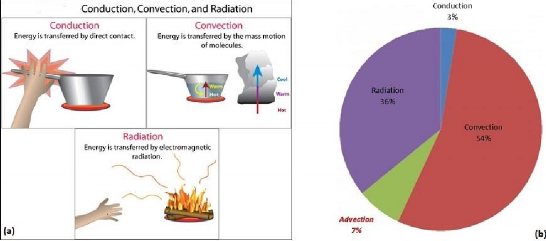1.2. Heating and Cooling of the Atmosphere
Sun is the ultimate source of the atmospheric heat and energy, but its effect is not direct. For example, as we climb a mountain or ascend in the atmosphere, temperature become steadily lower, rather than higher, as we might expect. This is because the mechanism of heating the atmosphere in not simple. Four common types of energy transport are involved in heating of the atmosphere (figure 3). They are:
1. Radiation: it is the process where transference of heat is directly from space to atmosphere through electromagnetic radiations2. Photon3 particles in the radiations collide with the air molecules in the atmosphere and transfer energy in this process. All objects whether hot or cold emit radiation continuously. The wavelength at which a body radiates depends on its surface temperature. The shorter the wavelength, higher the energy carried by the radiations The sun, having an extremely hot surface temperature, radiates fairly short wavelengths, part of which is felt as warmth, part of which are visible as light. The Earth, on
the other hand, having a cool surface, re-radiates heat at much longer wavelengths. The re- radiate heat from the earth is called Terrestrial radiation. Atmosphere is transparent to short waves and opaque to long waves. The long wave radiation is absorbed by the atmospheric gases particularly by carbon dioxide and the other green house gases. Hence energy leaving the earth’s surface heats up the atmosphere more than the incoming solar radiation.
2. Conduction: When two objects of unequal temperature come in contact with each other, heat energy flow from the warmer object to the cooler object and this process of heat transfer is known as conduction. The flow continues till temperature of both the objects becomes equal or the contact is broken. The conduction in the atmosphere occurs at zone of contact between the atmosphere and the earth’s surface by terrestrial radiations. However, this is a minor method of heat transfer in terms of warming the atmosphere since it only affects the air close to the earth’s surface. This is because of the fact that the air is poor conductor of heat4.
3. Convection: In this process, energy is transferred through motion of molecules itself. The air in contact with the earth rises vertically on heating in the form of currents and further transmits the heat of the atmosphere. The heating of the air leads to its expansion. Its density decreases and it moves upwards. Continuous ascent of heated air creates vacuum in the lower layers of the atmosphere. As a consequence, cooler air comes down to fill the vacuum. This process of vertical heating of the atmosphere is known as convection. The convective transfer of energy is confined only to the troposphere.

